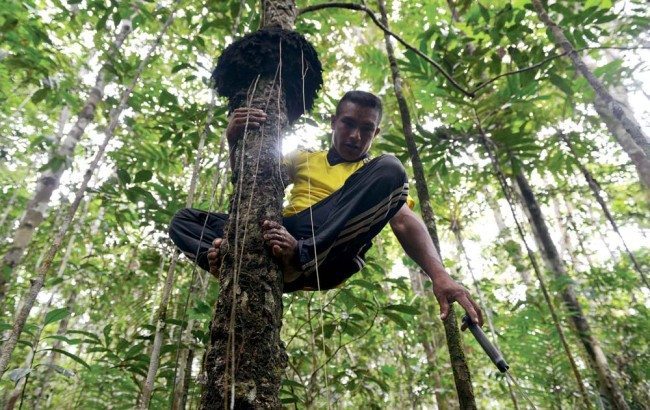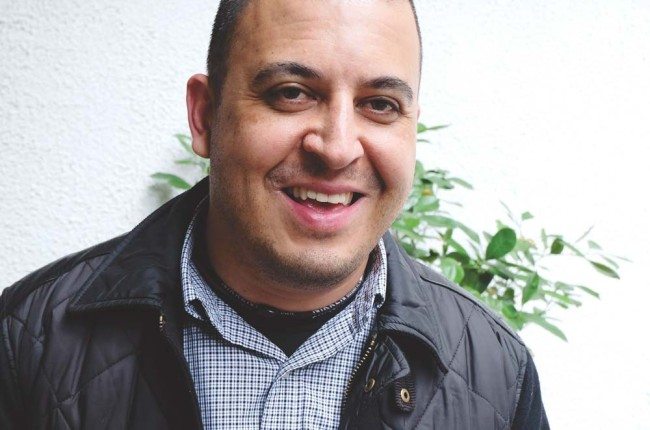[dropcap]F[/dropcap]or decades environmentalists, economists, and poets have tried to express what a tree is worth. It’s no easy task, but one Colombian has found a new way to measure the value of a forest that could change the way we think about the natural world.
The man trying to tell the globe it has gotten everything wrong with previous methods isn’t an Oxford or Ivy League-educated scientist.
Henry Arellano Peña is a Bogotá-born, 39-year-old, National University-trained Ph.D. who has scientists from Harvard to Brazil to Paris lining up to hear what he believes is a revolutionary way to calculate how much carbon dioxide is trapped in the planet’s tropical forests.
His results are alarming.

They suggest that deforestation — rampant in places like Brazil and Indonesia as society clear-cuts trees for agriculture, material goods, and other commercial uses — may have more impact on climate change than fossil fuel emissions.
“The world is beginning to change the way it looks at the alternatives, which contribute to the advance of climate change, such as deforestation and the degradation of our forests,” said Arellano.
“Our objective is to come up with solid proof that there are alternatives to the way we are treating our natural capital.”
A critical resource
When alive, a tree is a natural “carbon sink,” taking in CO2 from the atmosphere and holding it in its wood fibers for the rest of its lifespan. For this reason, planting more trees and preserving current forests are viewed as a critical component in ensuring that some of the carbon dioxide pumped out by power plants, mining operations, cars, and homes is filtered out of the sky.
Today’s accepted figure claims that 229 petagrams of carbon (pgc)— or 229 billion metric tons — are stored in the trees, bushes, vines, and other biomass throughout the world’s tropical forests from Ecuador to Sumatra.
Even this number, which comes from a 2012 study, was a major jump from previous estimates, and led researchers to conclude that up to 17 percent of manmade carbon emissions come from deforestation.

But Arellano’s life’s work has centered on finding a more precise way to measure the carbon value of a tree, and he believes that we have it all wrong. His calculations put the carbon stored in the world’s tropical forests at 724 pgc — more than three times higher than the figures reached in 2012.
He says that just the tropical forests in the Americas alone contain 383 pgc, which is above what previous methods say exist on the whole planet.
If he is right — and a lot of smart people across the world are listening intently to his reasoning — then that would mean that deforestation is the biggest contributor to climate change.
For all the political arm-wringing about the damage being done by coal-fired power plants in China, car culture in the United States, and India’s race to develop its way out of poverty, these industrial and automotive emissions are much less important than protecting the world’s forests, says Arellano.
Because if each hectare of the Amazon that goes up in flames is truly releasing as much carbon dioxide into the air as he believes, then this is what is really pushing greenhouse gas levels to historically unprecedented heights.
Arellano recently gave a presentation at Harvard University to a room of specialists. He lectured last month to some 90 researchers and officials from the Ministry of Environment in Brazil, a nation with staggering levels of deforestation. He has an upcoming talk at the University of Kansas in the United States.
And the United Nations has been discussing Arellano’s findings with Compensation International Progress (Ciprogress), the environmental company he works for in Bogotá.
The reason his methodology is so fascinating is its precision. Essentially, he is proving that a tree is not just a tree, as others have suggested.
The Intergovernmental Panel on Climate Change of the United Nations, for example, uses the basic estimate that half of the biomass of a jungle consists of carbon dioxide. Arellano has gone directly into the forests, however, and found that this figure can be off by up to 40 percent depending on the type of tree.
He uses tools to bore holes in trees in places where guerrilla landmines have been leaving holes in the earth — and the hearts of family members — for generations. Such fieldwork, in locations even intrepid scientists avoided for decades, has been invaluable to better understanding the biodiversity these jungles contain.
By taking samples, he is able to analyze the exact density and composition of trees. He also uses modern 3D-imaging techniques to get an exact picture of each tree.
The architecture of a tree
While in the past, simple formulas devised the amount of carbon stored in a tree by doing the math on its height, width and other basic info, new imaging captures what Arellano calls the full “architecture of the tree.” This includes all its branches, leaves, and the other nooks and crannies that the basic math could never understand.
Before the 3D technique — and before someone was willing to spend months in the forest charting thousands of trees — the only way to get such detailed data was to chop down the tree.
Now, Arellano does it all in a living jungle and is able to take his real-world-tested information out of the bush and into the halls of Harvard. His results aren’t solely based on fieldwork though.
He has also painstakingly created new maps of Colombia. Prior attempts to calculate the carbon value of a forests here have been done with rough, outdated maps that don’t truly depict growth on the ground.
Arellano has instead come up with computer mapping, based on satellite data and local knowledge, that refines our understanding of the forests. He is able to recreate a digital map of the physical world that, in the Santa Marta region on the Caribbean coast, for example, has pixels that are accurate down to a 5 cm by 5 cm piece of soil.

To simplify the significance of all these Ph.D.-level biology concerns, he compares previous methods of measuring the carbon-capturing ability trees to shoe sizes. Commercial retailers use about 10 different sizes, and this is good enough to give people a comfortable fit.
But it doesn’t work for trees.
There are thousands upon thousands of species of plant life in a tropical forest, so trying to call an Amazon jungle a size 8 and a Caribbean rainforest a size 10 is not doing it justice.
“With this methodology, you can identify the different plant formations and their respective contribution as a carbon sink,” said Arellano. “This goes much further than the simplification of forest vs. non-forest.”
While his work has global implications, Arellano is as focused on the local impact. If tropical forests truly do hold this much carbon, then protecting them is much more important.
In Colombia, as decreed by a 1992 amendment to the nation’s constitution, large swaths of land belong to indigenous communities. They are able to do anything they desire with their forests, and the difficult, impoverished lifestyle of many has led them to cut deals with oil and mining companies.
The real value of a forest
This subsequent degradation, or outright destruction, of the forest is a sad tradeoff, but as old ways of life become harder to maintain and development funds remain scarce for these populations, it is a decision many have been forced to make. C.i.progress and Arellano hope to provide these people with an economic alternative.
They are already engaged in projects with communities in Chocó, Valle del Cauca, Caquetá, Amazonas, and Guainía, among other areas, that are helping give ancestral owners of the land money and development resources simply to protect the forests that they oversee.
As we see further development of the international “carbon trading” market — a stock exchange where industrial companies, airlines, and others buy and sell credits to offset the carbon dioxide they put into the atmosphere — the company believes that the economic opportunities of protecting the jungle will only grow.
In short, Arrelano hopes that safeguarding the forest will soon be more lucrative than cutting it down. With the start of the 2015 United Nations Climate Change Conference in Paris on Monday, everyone from Pope Francis to U.S. President Barack Obama has been making news by warning humanity to the grave threats posed by climate change.
We may be reaching a tipping point in some countries towards understanding the concern.
Nearly two-thirds of people in the U.S. say they support Pope Francis’ call to action to combat climate change, according to a survey by the University of Michigan and Muhlenberg College.
This is Arellano’s ultimate goal. He wants the world, and especially Colombia, to appreciate its natural resources and realize their role in staving-off the dangers of climate change.
By more precisely calculating how much carbon a tree can store and how much revenue a forest can attract on the trading market, he is hoping people across the planet will come to better value trees in every sense of the word.
“I dream of the day when the accurate valuation of ecosystem resources are part of the quantification of national treasures and will be seen as an asset that has an equal value to money.”

